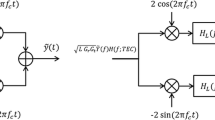Abstract
There is an emerging requirement for processing global navigation satellite system (GNSS) signals indoor where the signal is very weak and subjected to spatial fading. Typically, longer coherent integration intervals provide the additional processing gain required for the detection and processing of such weak signals. However, the arbitrary physical motion of the handset imputed by the user limits the effectiveness of longer coherent integration intervals due to the spatial decorrelation of the multipath-faded GNSS signal. In this paper, limits of coherent integration due to spatial decorrelation are derived and corroborated with experimental verification. A general result is that the processing gain resulting from direct coherent integration saturates after the antenna has moved through a certain distance, which for typical indoor propagation, is about half a carrier wavelength. However, a refined Doppler search coupled with a prolonged coherent integration interval extends this limit, which is effectively a manifestation of selective diversity.













Similar content being viewed by others
References
Broumandan A (2009) Enhanced narrowband signal detection and estimation with a synthetic antenna array for location applications, PhD Thesis, University of Calgary
Broumandan A, Nielsen J, Lachapelle G (2010) Enhanced detection performance of indoor GNSS signals based on synthetic aperture. IEEE Trans Vehicular Technol 59(6):2711–2724
Friedlander B, Scherzer S (2004) Beamforming versus transmit diversity in the downlink of a cellular communications systems. IEEE Trans Vehicular Tech 53(4):1023–1034
Fulghum TL, Molnar KJ, Duel-Hallen A (2002) The jakes fading model for antenna arrays incorporating azimuth spread. IEEE Trans Vehicular Tech 51(5):968–977
Kaplan ED, Hegarty C (2006) Understanding GPS principles and applications, 2nd edn. Artech House
Kim S (2004) Acquisition performance of CDMA systems with multiple antennas. IEEE Trans Vehicular Tech 53(5):1341–1353
O’Driscoll C, Borio D, Petovello MG, Williams Lachapelle T (2009) The soft approach: a recipe for a multi-system, multi-frequency GNSS receiver. Inside GNSS Magazine 4(5):46–51
Pany T, Riedl B, Winkel J, et al. (2009) Coherent integration time: the longer, the better. InsideGNSS November/December 2009
Parsons JD (2000) The mobile radio propagation channel, 2nd edn. Wiley, New York
Rappaport TS (2002) Wireless communications: principles and practice, 2nd edn. Prentice Hall PTR, Upper Saddle River
Rensburg C, Friedlander B (2004) Transmit diversity for arrays in correlated rayleigh fading. IEEE Trans Vehicular Tech 53(6):1726–1734
Van Trees HL (2002) Optimum array processing, part IV, detection, estimation, and modulation theory. Wiley, New York
Watson R, Lachapelle G, Klukas R (2006) Testing oscillator stability as a limiting factor in extreme high-sensitivity GPS applications. ENC, Manchester, UK, 8–10 May
Author information
Authors and Affiliations
Corresponding author
Rights and permissions
About this article
Cite this article
Broumandan, A., Nielsen, J. & Lachapelle, G. Coherent integration time limit of a mobile receiver for indoor GNSS applications. GPS Solut 16, 157–167 (2012). https://doi.org/10.1007/s10291-011-0215-y
Received:
Accepted:
Published:
Issue Date:
DOI: https://doi.org/10.1007/s10291-011-0215-y




